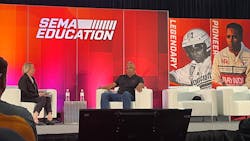SEMA 2023: HV Batteries, Willy T. Ribbs, and Emissions Compliance
At the SEMA Show 2023, education sessions were held all week long featuring various topics for attendees to pick and choose from, depending upon what they wanted to learn about. From general sessions about customers and branding to technical training, there was something for everyone.
NOLN attended a few sessions on the third day of the show, and here were some of the takeaways.
High-Voltage Battery Handling and Testing
Dirk Fuchs of Electric Mobility Consulting led a presentation about the importance of intentional safety when dealing with high voltage batteries like those seen in electric vehicles.
He told the audience to think of the human body as a conductor.
"Voltage is definitely a point, but the reality is the current is killing you," Fuchs said.
Fuchs emphasized investing in proper PPE for battery handling, such as lineman's gloves. The presentation outlined some of the hazards that go along with HV batteries as well, including electrical hazards (highly conductive gas, arcing potential, stranded high voltage), toxic hazards, and high flammability and combustibility.
Flammability was driven home through several photos and videos of electric vehicles catching fire due to batteries overheating. Fuchs shared an example of a totaled vehicle where the technicians didn't know how to remove the battery so the vehicle sat for two months in the summer heat. Due to this, the battery started fire. For reference, the presentation shared the average EV fire with no water cooling is one hour and 34 minutes.
While the topics touched upon in this presentation were serious, the motivation was to encourage proper planning and protection to lessen the chances of something disruptive or damaging happening. It was also suggested to the audience to work with the local fire department and ensure that a plan is in place, process-wise, so that HV battery fires can be properly mitigated with less hazardous waste as a result.
Willy T. Ribbs Fireside Chat
For his first-ever SEMA Show experience, acclaimed race car driver and Formula One DEI Ambassador Willy T. Ribbs was joined by discussion moderator Beth Paretta of Paretta Autosport for a conversation about his life and legacy.
Ribbs began his racing career in the United Kingdom, having decided to go overseas to try his hand at the sport. His father was a motorcycle racer and a race car driver himself, and even built his own race cars. So Ribbs understood the technical side of things, but he had never raced prior to going overseas. Nevertheless, his parents gave him the money that would have gone toward his collegiate career so that he could give racing a go.
The results were impressive, to say the least. Ribbs got third in his very first race and won his second. Fast-forward throughout the rest of his career and there are many accolades to be found, including becoming the first African American driver to both test a Formula One car and compete in the Indianapolis 500.
During the conversation, Ribbs reflected on some of the criticism he has gotten in the past, such as being called "arrogant" by the media. But he has taken it all in stride.
"Opposition always got me excited," Ribbs said.
Currently, Ribbs is in his second year as a diversity, equity, and inclusion ambassador for Formula One. It's a role, and a topic, that he finds great value in.
"The best always happens when you have all people, all brains, together," Ribbs said.
Emissions Compliance: What You Need to Know
In a panel discussion moderated by David Goch, esquire at Webster, Chamberlain, and Bean, the California Air Resources Board (CARB) and CARB Executive Order (EO) application process took center stage.
There are many complexities to this topic, but Lisa Yacoubian, assistant division chief at CARB provided an overview as to what the application process is like for assuring compliance with aftermarket products and parts. An aftermarket part is defined as something that was not originally on a manufactured vehicle.
In order to achieve certification by CARB's standards, there is a fee to be paid and an application process that may involve testing as the application is reviewed to ensure compliance. The executive order is granted once all the steps are completed.
Peter Treydte, director of emissions compliance at SEMA, spoke to the audience about the opportunities available with SEMA Certified-Emissions, a program "designed around the guidance of the EPA Tampering Policy."
"Depending on what your ultimate needs are, we can tailor the process accordingly," Treydte said.
According to Treydte, the EPA Tampering Policy emphasizes "reasonable basis" demonstration of compliance, and to demonstrate emissions compliance you must have a "documented reasonable basis." This means an evaluation, that may require testing, is required.
Treydte also outlined some other key points of emissions compliance, including:
- The Clean Air Act, which requires a demonstration of emissions compliance for aftermarket parts as clarified by the Tampering Policy;
- The CARB California Vehicle Code, which requires aftermarket parts have a CARB EO to be legal in the state of California;
- CARB EO, which makes a product legal in all 50 states.
The SEMA Show was held October 31 through November 3 at the Las Vegas Convention Center in Las Vegas, Nevada.
About the Author
Hanna Bubser
Editor
Hanna Bubser is the editor of National Oil and Lube News and has been writing about the automotive aftermarket since 2022. She has a bachelor's degree in English from Hamline University in St. Paul, Minnesota. As a teenager, she drove a green 1996 Jeep Cherokee that was previously used as a forest service vehicle. Currently, she drives a 2019 Subaru Impreza. She's an avid bumper sticker collector and loves adorning her vehicle with brightly-colored conversation starters.

